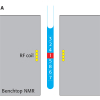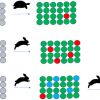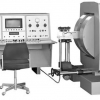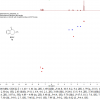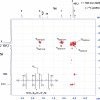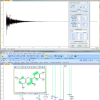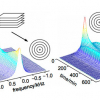Antony N. Daviesa,b
aExpert Capability Group – Measurement & Analytical Science, AkzoNobel, Deventer, The Netherlands
bSERC, Sustainable Environment Research Centre, Faculty of Health, Sport and Science, University of Glamorgan, UK
The age of the GHz nuclear magnetic resonance (NMR) spectrometer is almost upon us. Breaking through the 1000 MHz barrier has the potential to deliver a step-change in the information content, not just as another way to deliver NMR data with even more unbelievable resolution—but possibly more exciting—the enhanced ability to deliver studies of samples in their more natural environments. The long struggle between protein crystallographers and NMR protein structure specialists about who is “right” has received a new twist with studies showing the vision of revealing information through protein imaging measured inside cells themselves. Not only are the biologists and biochemists excited about this potential, chemists who have been studying reactions using NMR in situ for many years may now have the chance to start monitoring and imaging chemical processes on an unheard-of scale and resolution. This may be a vital tool in gaining knowledge about how multi-phase systems operate and develop.
The arrival of the 1000 MHz instrument at the European Nuclear Magnetic Resonance Center (CRMN) in Villeurbanne, France, during 2009 was widely acclaimed—not only in terms of the ground-breaking nature of the instrument’s powerful superconducting magnet (23.5 Tesla), but also the amount of funding required to be put in place. And these costs do not just stop at the purchase of the instrument, since the total cost of ownership clearly needs to be taken account of by organisations hoping to lead in this field.
With a reputed purchase price of around €11 million, clearly some sort of governmental involvement is likely to be required. In this case, the load was spread between French national and regional organisations. As with earlier large magnets, you also need to have a building dedicated to housing your investment (Figure 1), as the Lyon instrument weighs in at 12 tons and is over five metres tall (no jokes about high-field magnets please!).

Who wins?
Now clearly the structural biochemists will have viewed the arrival of even higher field strength magnets with glee—happily predicting major advances in the structural analyses of proteins, for example. But even at these field strengths, the molecules of interest deliver complex spectra difficult to interpret unless separated from their normal background environment or matrix. One thing is clear, like a water torture, the slow drip, drip of higher field systems arriving on the market will eventually force many of the most complex biological structures to reveal their innermost secrets. Special probes have been developed to allow for imaging and it is possible that the next steps will allow for the imaging structural analysis of proteins functioning in their correct cell wall matrix, surrounded by the other entities that need to be present to complete the overall picture of a functioning biological system but that currently make data interpretation such a difficult task. There are some classes of proteins, for example, which reportedly only deploy in their active structural configuration when located inside their cell walls—meaning that the data from extracted, purified and crystallised examples only provides part of the picture. So roll on 1.2 GHz!
Funding research & development
As mentioned above, the funding of such critical investments almost always means that they will be part of some centralised facility with extensive government backing. This is true in France and also in The Netherlands, where Professor Dr Marc Baldus of the NMR Spectroscopy Research Group, Bijvoet Center for Biomolecular Research, Utrecht University, recently presented the vision being realised by the multi-university Netherlands NMR collaboration. This includes the arrival, this year, of a 950 MHz instrument and the planning for a significantly stronger magnet in the medium term. The degree of excitement and expectation such an investment brings to the collaborators who have fought to convince the governmental funders of the essential nature of keeping at the forefront of scientific development was clear during the presentation. Access to the newly deployed systems will, of course, need to be tightly controlled as with any scarce resource. Professor Baldus hinted at a clear requirement to document why only the very highest field strengths can give the scientific answers being sought by hopeful applicants for instrument time.
In contrast to the good news coming out of France and The Netherlands, just to name two initiatives, the story on the other side of the Atlantic looks much bleaker. Even with a history of ground-breaking investment in high-field NMR facilities across Canada, last years’ announcement of the elimination of the Major Resources Support (MRS) and Research Tools and Instrument (RTI) programs of the Natural Sciences and Engineering Research Council (NSERC) threatens the existence of most of the high-field systems accessible to Canadian scientists. Since MRS funding supports the National Ultrahigh-field NMR facility for Solids in Ontario (900 MHz) established in 2005, QANUC – The Quebec/Eastern Canada high field NMR facility (up to 800 MHz) established 2005 and NANUC, the somewhat older National Facility for High Field NMR Resource for Applications in Chemistry completed in 1999 in Alberta with their 800 MHz instrument.
Now clearly science cannot be immune from the general economic situation in which we find ourselves, but I would hope that it is the shared facilities, where scientists from the widest number of locations can enjoy access to state-of-the-art equipment, that are precisely those organisations which should be protected when the purse strings get tight—and probably even have their position strengthened. Any country that thinks it can create and innovate its way out of a recession needs to look to its science infrastructure as a vital source of inspiration, rather than cutting back on the tools required to make that innovation happen and demotivating some of the countries’ most inspirational field leaders. The double-whammy, to coin another phrase from across the Atlantic, is that of course by demotivating your young talented scientists you also encourage them to seek pastures new where the facilities are available for them to advance their careers—thereby strengthening potential competitor countries as we fight to get our economies moving again.
Conclusions
Finally, I would also like to voice a word of praise to the instrument vendors for continuing to push the boundaries. The ground-breaking developments along the lines we have witnessed in the past 10–20 years can only be made with the steady, robust commitment to quality and innovation which, in the case of these ultra-high field superconducting systems, requires an expensive combination of multidisciplinary, technically gifted people working with and under the guidance of managers with vision and a clear strategy. They also need to be capable of convincing the purse-holders of the necessity of continuous improvement. Take note governments—this is something we are sometimes really good at!


